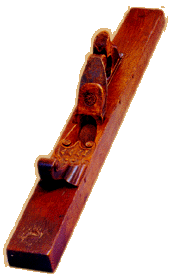 The jointer plane is the longest plane in the family of bench planes. Due to its length, it is the most
accurate The jointer plane is the longest plane in the family of bench planes. Due to its length, it is the most
accurate  of bench planes.
Its purpose is to plane the edges of boards to a straight edge so that multiple boards can
be glued together without gaps. It is also used for flattening table tops and planing
longs boards flat. The length of the plane makes it possible to form a straight surface
where a shorter plane would follow the dips and curves already in the wood. Planemaking
became a distinct trade in the late 1600's and was industrialized in heavy production in
the late 1800's. This fine example shows a particularly 18th century Dutch style where the
plane was wonderfully carved. The blade is about 2 1/2" inches wide, a typical width
for a long plane. Planes were usually made from beechwood, although many exotic species
were used by shipwrights who made their own tools. Any hard stable wood works well,
although changes in the weather can cause the wood sole to move and change the accuracy of
the tool. The handle (or tote (US), or toat (UK)) is offset to aid the balance when right
handed planing. In the next fifty years handles were centered and the decoration vanished.
Exactly why planemakers took the time to decorate their planes at this time is unknown
(though pride of craftsmanship and ownership undoubtedly played a part), but certainly the
decoration is a refection of the original cost of the tools and the importance they held
in the eyes of the joiners of the period. Another interesting point is that this tool has
a single blade. It wasn’t until the next century that a cap iron was added to bench
planes to break the wood shaving as it was formed and to reduce tearout in the wood. The
blade on this plane is quite thick and didn't vibrate much. Later metal planes, such as
the entire range of Bailey (Stanley) iron bench planes, had much thinner blades and the
cap iron helped to dampen vibration. Get a closer
view of the object (56K) of bench planes.
Its purpose is to plane the edges of boards to a straight edge so that multiple boards can
be glued together without gaps. It is also used for flattening table tops and planing
longs boards flat. The length of the plane makes it possible to form a straight surface
where a shorter plane would follow the dips and curves already in the wood. Planemaking
became a distinct trade in the late 1600's and was industrialized in heavy production in
the late 1800's. This fine example shows a particularly 18th century Dutch style where the
plane was wonderfully carved. The blade is about 2 1/2" inches wide, a typical width
for a long plane. Planes were usually made from beechwood, although many exotic species
were used by shipwrights who made their own tools. Any hard stable wood works well,
although changes in the weather can cause the wood sole to move and change the accuracy of
the tool. The handle (or tote (US), or toat (UK)) is offset to aid the balance when right
handed planing. In the next fifty years handles were centered and the decoration vanished.
Exactly why planemakers took the time to decorate their planes at this time is unknown
(though pride of craftsmanship and ownership undoubtedly played a part), but certainly the
decoration is a refection of the original cost of the tools and the importance they held
in the eyes of the joiners of the period. Another interesting point is that this tool has
a single blade. It wasn’t until the next century that a cap iron was added to bench
planes to break the wood shaving as it was formed and to reduce tearout in the wood. The
blade on this plane is quite thick and didn't vibrate much. Later metal planes, such as
the entire range of Bailey (Stanley) iron bench planes, had much thinner blades and the
cap iron helped to dampen vibration. Get a closer
view of the object (56K)
"The Joynter is made somewhat longer than the Fore-plane, and hath
its Sole perfectly straight from end to end.. Its Office is to follow the Fore-plane, and
to shoot an edge perfectly straight, and not only an edge, but also a Board of any
thickness; especially when a Joynt is to be shot. Therefore the Hand must be carried along
the whole length, with an equal bearing weight, and so exactly even, and upright to the
edges of the Board, that neither side of the Plane encline either inwards or outwards, but
that the whole breadth be exactly square on both its sides; supporting its sides straight:
so will two edges of two Boards, when thus shot, lie so exactly flat and square upon one
another, that light will not be discerned betwixt them."
Excerpt from "Mechanick Exercises or the Doctrine of
Hand-Works" by Joseph Moxon. 1994 Astragal Press reprint of the 1703 edition. The
original spelling and syntax has been retained in this excerpt.
Suggested further reading:
|
![]()
 The jointer plane is the longest plane in the family of bench planes. Due to its length, it is the most
accurate
The jointer plane is the longest plane in the family of bench planes. Due to its length, it is the most
accurate